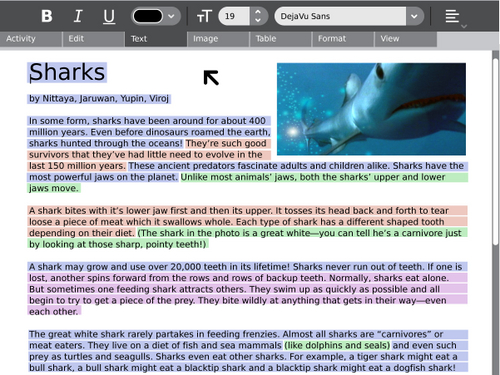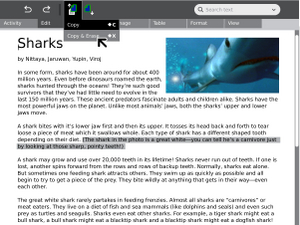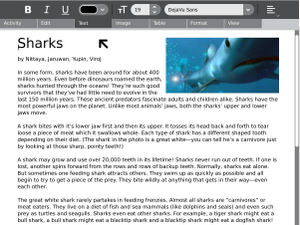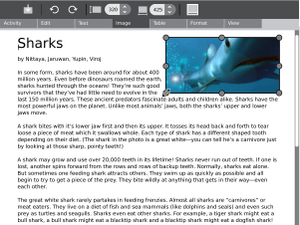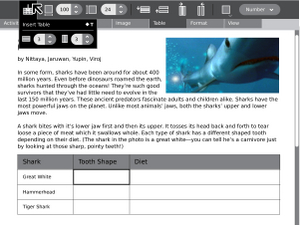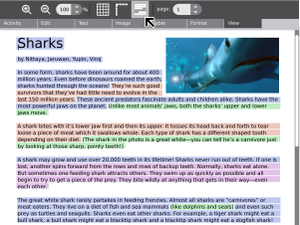Write: Difference between revisions
| Line 21: | Line 21: | ||
===Current Use === |
===Current Use === |
||
'''Additional instructions should be added here as more document formats become available. See [[Talk:Write|Discussion]].''' Also see a step-by-step example of how to use Write [[Write/Escribir]] here. |
|||
How do you save it? |
How do you save it? |
||
| Line 30: | Line 31: | ||
When should you use the "Keep" button in the Activity tab? |
When should you use the "Keep" button in the Activity tab? |
||
:When you want to save a copy, or save a copy in another format, such as plain text, HTML or RTF (when available). |
:When you want to save a copy, or save a copy in another format, such as plain text, HTML or RTF (when available). |
||
Additional instructions should be added here |
|||
as more document formats become available. |
|||
See Discussion. |
|||
How do you save to a new location, such as an SD card or USB device? |
How do you save to a new location, such as an SD card or USB device? |
||
Revision as of 03:47, 2 March 2008
see more templates or propose new |
Description & Goals
Summary
The Write activity serves as the basic text editing application on the laptops. Its simple interface provides an easy starting point for children, presenting tools that make writing a story, poem or essay simple and straightforward. It also supports basic tools for inserting images, creating tables, and performing basic layout operations as children begin to require some of these features often associated with word processors. (For developer-level Linux text editing, see Nano.)
Current Use
Additional instructions should be added here as more document formats become available. See Discussion. Also see a step-by-step example of how to use Write Write/Escribir here.
How do you save it?
- Your work is automatically saved in the Journal as "Write Activity" or the name you last gave it.
How do you name it?
- Click the Activity tab and overwrite the words "Write activity" with the name you want displayed in the Journal, or rename it with the Journal.
When should you use the "Keep" button in the Activity tab?
- When you want to save a copy, or save a copy in another format, such as plain text, HTML or RTF (when available).
How do you save to a new location, such as an SD card or USB device?
- See Journal. Insert the storage device. Wait until its icon is visible at the bottom of the Journal.
- Name the document, "keep" to whatever format you want, and exit. Open Journal. Find your freshly written document. Click, hold the left trackpad button, and drag the document name to the bottom of Journal. Release when the pointer is over the icon for your SD card or USB storage device.
How do you open a plain text document from an SD card or USB storage device?
- Make sure the device is mounted, as described above.
- Click on the device icon at the bottom of the Journal.
- Wait for the Journal to display the contents of your storage device.
- Click on the document name.
How do you transfer documents between XO Write and Microsoft Word?
- As of December 2007, an XO Write document was saved in AbiWord format, which could not be opened by Microsoft Word without conversion.
- Workaround 1: If you have access to a Windows, Mac,or Linux PC, XO Write's parent program, AbiWord, will help. AbiWord can read and write Word files. You should be able to open XO Write documents in AbiWord, then save in RTF or MS Word ".doc" format -- or continue working on the document in AbiWord itself. See http://www.abisource.com/download/
- Workaround 2: Use plain text. To transfer FROM the XO, first "Keep" the document as plain text. To transfer TO the XO, you can create a document with MS Word or another program and save it as plain text before putting it on a USB drive for transfer, or e-mailing it to an address you access from the XO.
- Note: Plain text saves only the words and paragraph breaks, but often is a "good enough" solution for many writing activities.
- Future: Write's Keep button also offers the alternatives of saving as HTML or RTF, both of which should preserve font characteristics and page layout. However, the RTF conversion was not functioning on G1G1 XOs delivered in December 2007. See this page's discussion tab.
Collaboration
Write will feature collaborative real time editing. Integrated with the mesh network and presence services, this feature will allow kids to work together easily and seamlessly in a text editing environment. This feature is made possible via the Abi Collab research performed by the Abiword development team.
Visual Design
Media
| Document | Description |
|---|---|
| Activity Mockup (2MB) history | Adobe Illustrator file containing mockups for each toolbar |
Screenshots Mockups
21Jan2008 -- These pictures are really misleading: 1) They are not "Screenshots" 2) They do not accurately show the program screens. -- SFDave
Development
Feature Requests
Microsoft Word capability
- Write (Abiword) already supports .doc; Journal support for "save as" needs to be exposed in the interface.
- I Disagree that write should have an option to save to the proprietary and vendor-locked .doc format. It's use should not be encouraged by OLPC.
Publish Function
- Publish to PDF for Final Output
- Publish to HTML/XHTML
Double spacing in the format section
Implementation Discussion
Version History
Source
http://dev.laptop.org/git.do?p=projects/write
RPMs
Resources
Functional Test
Open the Write activity.
Type some text. Change the font. Ensure that bold and underline work properly.
Save the document.
Close the activity; ensure that it closes properly.

